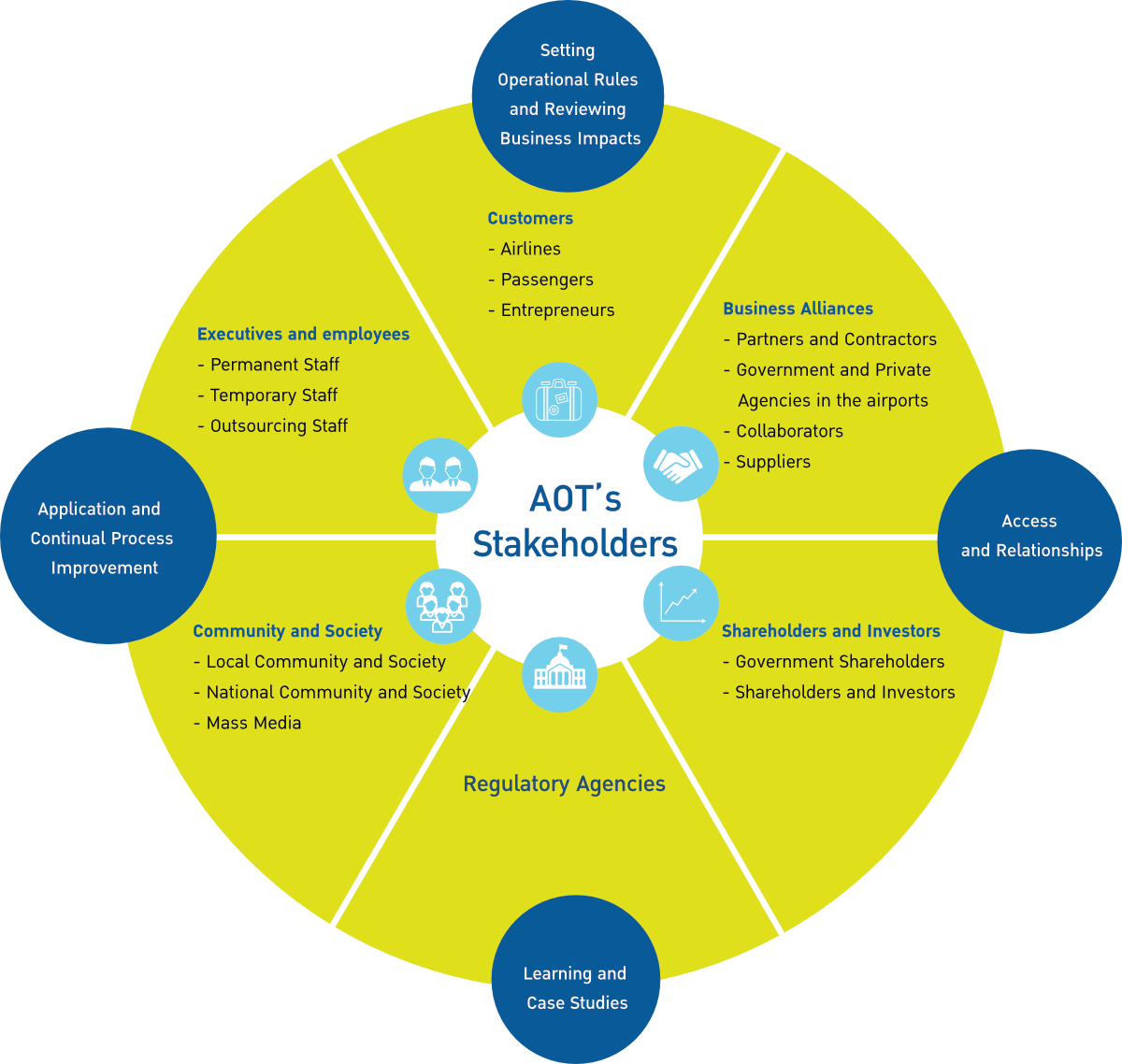Processes for Defining Report Content
The process for defining sustainability report content is consistent with the GRI Standards 2021. The processes are divided into 4 main steps as follows:
Step 1
Understanding AOT’s Contexts
AOT collects information on all business activities (services and capacity expansion at all 6 airports) and 7 groups of AOT
stakeholders (customer, business alliances, regulators, AOT employees, community and
society, mass media and other online media, and financial management, shareholders,
investors and securities analysts) throughout the value chain, including economic, environmental and social issues related to AOT to understand AOT contexts and be a database to define the report content in
the next step.
Step 2
Identifying Impacts
AOT collaborates with stakeholders and sustainability experts to identify economic,
environmental and social impacts, including human rights issues arising from AOT's business activities. It covers comprehensive impacts
both actual and potential, positive and negative, short and long term, intended
and unintended, and reparable and irreparable consequences.
Step 3
Impact Assessment
AOT works together with sustainability experts to assess the impact of step 2 in 4 areas: scale of impact, scope of impact, irremediability, and likelihood of occurrence to determine the level of impact, covering human rights effects.
Step 4
Ranking for report
AOT prioritizes the impact through the engagement process of stakeholders who
are affected and sustainability experts to consolidate the impact at a ranking level
(most important, very important, and important)
and present and seek approval from the Corporate Social Responsibility Committee
for sustainable development and the Corporate Governance Committee to report on the
key sustainability issues of AOT.
* Remark: AOT has a plan to ensure the accuracy of information in the Sustainability Report by independent organizations in the future. The information currently disclosed is information that has been internally validated by the management of each department
AOT's Materiality Metrix
The following are 16 material topics that have been identified and assessed by internal and external stakeholders in economic, social, and environmental dimensions.
Most Important
Very Important
Important
- Customer satisfaction
- Business Alliances
- Corporate Governance, Risk Management, and Work Compliance
- Sustainable Supply Chain
- Digital and Innovation
- Energy and Climate Change
- Circular Economy
(Waste Management)
- Airport Safety and Security
- Occupational Health and Safety
- Airport Capacity and Accessibility
- Information Technology and Privacy
- Water and Wastewater
Management - Noise Impacts
- Participation with Community and Society
- Human Rights
- Valuable and Life Fulfilling
Scope of Impacts on Stakeholders
To improve business efficiency and to fulfill stakeholder expectations, AOT has identified the impacts of each material topic on different types of stakeholders as follows:
| Important Sustainability Issues | Scope of Impacts on Stakeholders | |||||||
|---|---|---|---|---|---|---|---|---|
| Internal | External | |||||||
| AOT Employees | Customers | Business Partners | Regulators | Communities and Societies | Mass Media and Online Media | Shareholders, Investors, and Securities Analysts | ||
Economic Dimension |
Corporate Governance, Risk Management, and Work Compliance | ✔ |
✔ |
✔ |
✔ |
✔ |
✔ |
✔ |
| Airport Capacity and Accessibility | ✔ |
✔ |
✔ |
✔ |
||||
| Customer Satisfaction | ✔ |
✔ |
✔ |
|||||
| Sustainable Supply Chain | ✔ |
✔ |
✔ |
✔ |
||||
| Business Alliances | ✔ |
✔ |
✔ |
|||||
| Digital and Innovation | ✔ |
✔ |
✔ |
✔ |
✔ |
✔ |
||
| Information Technology and Privacy | ✔ |
✔ |
✔ |
✔ |
✔ |
✔ |
✔ |
|
Social Dimension |
Occupational Health and Safety | ✔ |
✔ |
✔ |
✔ |
✔ |
✔ |
|
| Participation with Community and Society | ✔ |
✔ |
✔ |
✔ |
✔ |
|||
| Participation with Community and Society | ✔ |
✔ |
✔ |
✔ |
||||
| Human Rights | ✔ |
✔ |
✔ |
✔ |
✔ |
✔ |
✔ |
|
| Valuable and Life Fulfilling | ✔ |
|||||||
Enviromental Dimension |
Energy and Climate Change | ✔ |
✔ |
✔ |
✔ |
✔ |
||
| Water and Wastewater Management | ✔ |
✔ |
✔ |
|||||
| Circular Economy (Waste Management) | ✔ |
✔ |
✔ |
✔ |
||||
| Noise Impacts | ✔ |
✔ |
✔ |
|||||
AOT’s Stakeholders
AOT identifies and selects key stakeholders from those who are involved and whose interests may be affected by or have a high influence on AOT's business throughout its value chain. AOT also takes significant measures to control impacts on communities surrounding the airports in compliance with the Environmental Impact Assessment (EIA), the Airport Emergency Plan, and the Noise Contour Assessment.
AOT reaches out to stakeholder groups using 4 tools: Access and Relationships, Learning and Case Studies, Setting Operational Rules and Reviewing Business Impacts, and Application and Continual Process Improvement.

| Stakeholders | Methods | Expectations | Responses | |
|---|---|---|---|---|
| Customers |
|
|
|
|
| Business Partners |
|
|
|
|
| Shareholders, Investors, and Securities Analysts |
|
|
|
|
| Regulators |
|
|
|
|
| Community and Society |
|
|
|
|
| AOT Employees |
|
|
|
|
| Mass Media and Online Media |
|
|
|
|
Last updated: August, 25 2023
